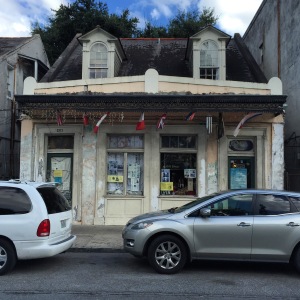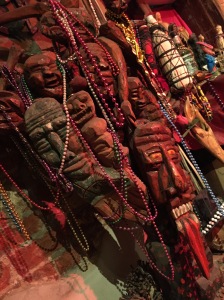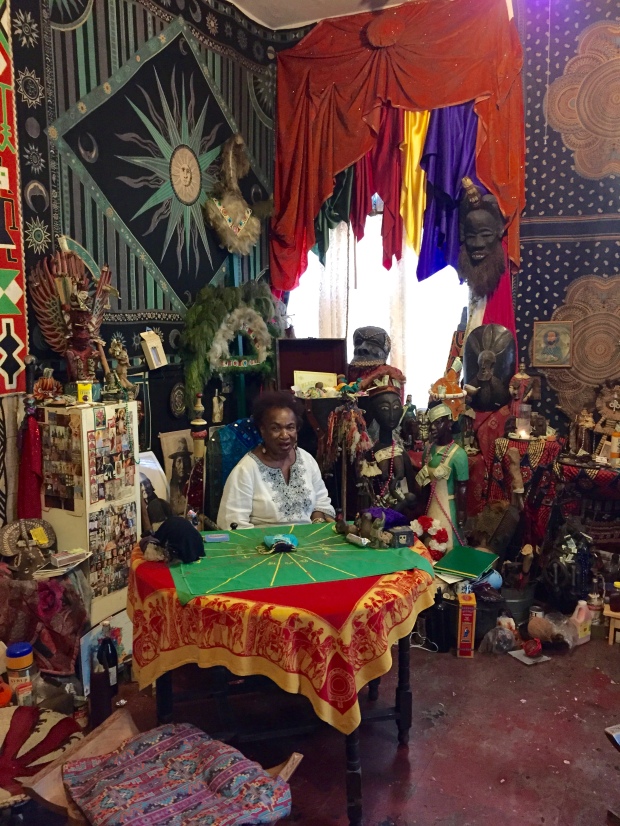Voodoo
This is my first visit to New Orleans. Technically speaking, it’s my second, but I was barely three years old the first time so I don’t remember it at all. My mother tells me I got lost in the middle of a crowd and that she’s forever grateful to the police officer who found me and carried me on his shoulders so my parents could spot me. If ever there was a city preceded by its reputation, it is this. Even months away from Mardi Gras, the French Quarter is bursting with revelers. Walking through these streets after dark is an assault to the senses, all five of them. This is not a place to go in search of the sacred. Or, is it?

Voodoo Spiritual Temple
New Orleans was on my list from the beginning of this project. I came here searching for a unique spiritual landscape, and half a day into my visit, I’m convinced I’ve found just that. My first priority was to explore the culture, tradition and practices of Voodoo. To that end, I headed straight for the Voodoo Spiritual Temple and Cultural Center. I would have missed the nondescript, little building had I not known exactly what it looked like from the photos I found in my research.
As I walked into the place, I found myself in the middle of a shop filled with voodoo dolls, incense, and all sorts of paraphernalia and artifacts for sale. The attendant at the desk was very kind and informed me that the priestess was in the middle of a reading and wouldn’t be available for another hour. I explained I’d called a few times and left messages, I didn’t mean to simply barge in. After I explained the reason for my visit, she asked if I’d been to the Voodoo Museum and said it was just a few blocks down. We agreed I’d go visit the museum and come back to talk with Priestess Miriam Chamani, founder and Queen Mother of the temple.

In the Voodoo Museum
All I knew about Voodoo before today was the Hollywood narrative and the scary stories I heard in church youth group about evil forces and dark spirits. It is a very marketable story and it makes for excellent entertainment. But beyond the kitsch and the lore, there is a very rich history and tradition that thrives to this day among private societies where true Voodoo is practiced. But it’s not easily found. Walking into the New Orleans Historic Voodoo Museum, I find myself again in a store with all sorts of paraphernalia and gifts. At the back of the shop, behind a desk, sits Dr. John T. Martin, Voodoo Priest and museum keeper. I ask a few questions, pay my admission fee and walk into the museum area. It is a small space, but it is chock full of altars, artifacts, portraits, statuettes and other various items.
The room at the back houses a main altar and a legend that reads:
“This is typical of the type of altar that may be found throughout Louisiana. This is a working altar and is frequently used in rituals and changed around to invoke and propitiate different spirits. The Catholic Saints represent the Voodoo Spirits. Candles, incense, oils, cigars and other such items are used as offerings. A glass of water is present to absorb negative energies and a few drops are sprinkled on the altar daily to refresh the spirits. The center pole is believed to serve as a channel for the Spirits to come down. During a ceremony, offerings of food and drink are made, then may be consumed by the participants after they have been blessed. The drums are used to summon the spirits and various dances are performed as offerings and to facilitate possession of the dancer by the spirits.”

Voodoo Altar
Although my knowledge of Voodoo is minimal, there is a lot about this room and these artifacts that feels familiar. I’m reminded of spiritual healers and practices I grew up around in Mexico. The way that West African practices mixed with European Catholic beliefs in Louisiana, is reminiscent of the way Prehispanic spiritual traditions mixed with Catholic beliefs in Mexico. I’ve always been interested in this syncretism that breeds a new kind of spirituality. In Mexico, for instance, Day of the Dead is the product of Prehispanic spiritual practices and Catholic tradition. Dia de Muertos as we know it did not exist before the clash of these two worlds.
Voodoo originated as a collection of socio-political-religious practices native to West Africa. In this religious practice, devotees experience a direct contact with the spirits. And the word “voodoo,” well, it simply means “spirits.” The Museum’s guide dispels the notion that Voodoo is evil and black magic. Instead, it claims that Voodoo is benign, “A selfish desire is considered an evil intent. Usually a Voodoo Priestess (Queen) or Priest (Doctor) will reject any request to make an evil petition to the spirits. A portrait of Marie Laveau is one of the centerpieces of the museum. Laveau was a famous healer and is considered the matriarch of New Orleans Voodoo. Born a “free woman of color” in 1801, she came to be known as a devout Catholic and humanitarian.

Dr. John T. sits under the portrait of Marie Laveau
After visiting the corridors and rooms of the museum, I had a brief conversation with Dr. John T. He was holding a small python in his arms, which I don’t remember noticing when I first arrived. We exchange a few pleasantries and then I tell him why I am in New Orleans. “I’m here looking for sacred spaces,” I say. His face changes, I feel like I’ve just said something wrong, then after a second or two, almost whispering he says, “They are few and far between.” He is speaking so softly I’m actually struggling to hear him, so I lean in a little closer. He bemoans the fact that the practice of Voodoo has lost its true meaning, and I think of all the “Voodoo” t-shirts and tchotchkes I’ve seen walking down the streets just this afternoon. And then he tells me, again in the softest whisper, that most practitioners keep private altars. He himself doesn’t much open his home altar to outsiders. He tells me of a few other places I should visit and people I should talk to. This is great, it’s what I was hoping for, and I’m still surprised that the mention of “sacred spaces” brought this on, as though I spoke a code word I didn’t even know I had.
Back at the Voodoo Spiritual Temple, I finally meet Queen Mother Miriam. She is a joyous presence, dressed in bright colors and looking quite regal. It has been a long and draining day for her, filled with private consultations. But she kindly entertains a few of my questions and regales me, the attendant, and a couple other visitors with parables about seeking. This, because when asked what tradition I practiced I answered that I was a seeker. She asks me to come back for a proper visit and we make arrangements for Monday. I can’t express how thrilled I am, this is my first contact with Voodoo and I get to visit with a Queen Mother.
It’s getting late and I haven’t had lunch or dinner, so I look for a place to eat. Night has fallen by the time I leave the restaurant. My walk back to the hotel takes me through Bourbon Street, and what an experience that is. People, people, and more people, walking, laughing, drinking, having a good time. It’s exciting, it’s what the French Quarter is all about. And it’s also a little strange for me, I feel a little lost. These are profane spaces, what am I doing here? My answer comes moments later when I notice a man and a woman praying over a bar tender on the sidewalk. They each have Bibles in their hands and they are wearing t-shirts with Christian slogans, “Ask me how Jesus can change your life,” “Not ashamed of the Gospel of Jesus Christ.” I wait around for them to finish praying and I approach them. “Are you with a church?” I ask. “Yes,” the man replies. He goes on to explain that they are here just about every night, expecially on the weekends, and they go around praying for the workers on Bourbon Street. He is very warm and genuine, there isn’t an ounce of judgment in his words. I look around and see nothing but the kind of environment an Evangelical Christian would typically stay as far away from as possible. “It must be very difficult to do the work you do here,” I say. “Not really,” the woman affirms. The man (I didn’t get their names) tells me ther rarely experience rejection or confrontation. In fact, he tells me, it is quite often the case that people accept Jesus Christ as their Savior right here on these sidewalks. “That’s pretty amazing,” I say. “You see,” he tells me, “When you are in a very dark place, all you need is a match to light the way. And we don’t have a match, we have the most powerful light of the Gospel of Jesus Christ.”

Preaching and praying along Bourbon Street
They’re busy doing their rounds and I’ve detained them long enough, so we agree to meet again tomorrow night. But they leave me with the assurance that I am in the right place. I’m learning that the sacred and the profane are oftentimes found right next to each other. In fact, they are often so intertwined you can’t have one without the other. I think this is going to be a great week.





